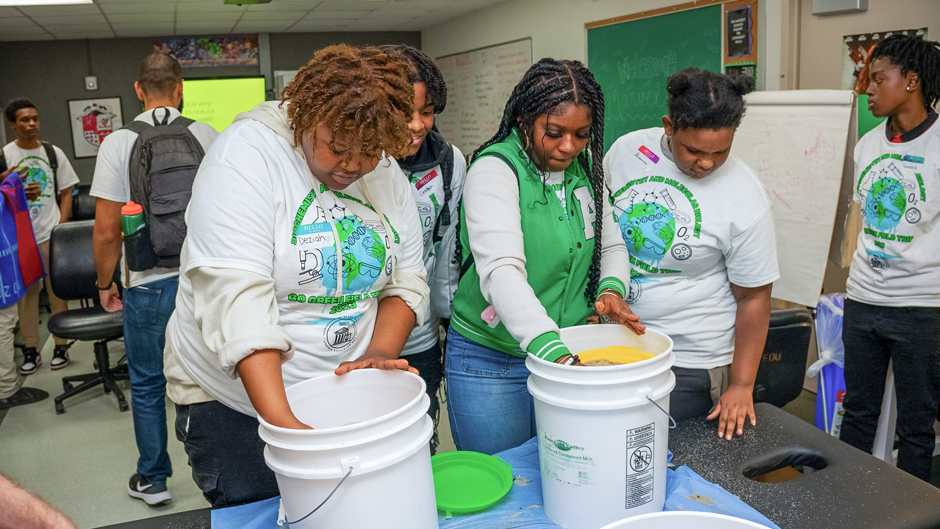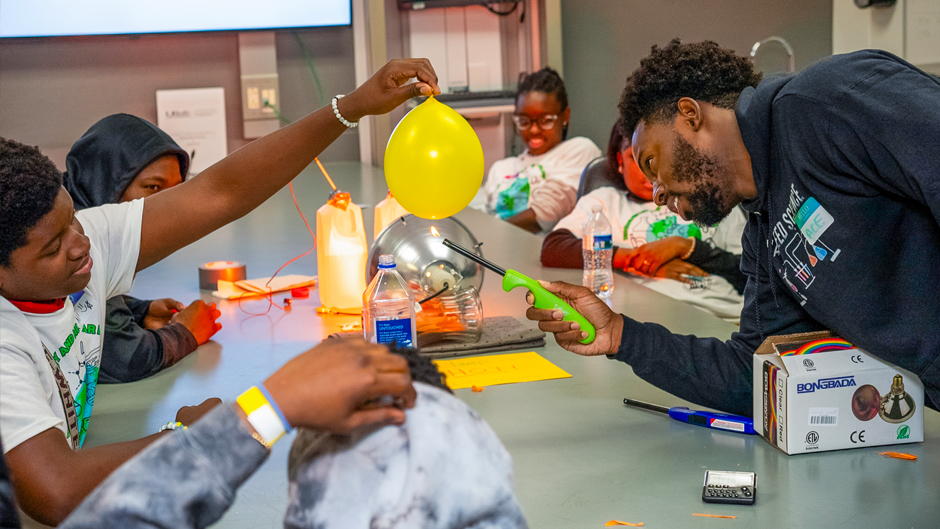The water-filled balloon lasted quite a while but could not endure. After nearly two minutes of being exposed to the flame from a butane lighter, it finally ruptured, saturating a section of the floor beneath it and Deziah Kingkade’s hands.
But Kingkade, who had been holding the lighter next to the balloon, didn’t mind. It was all done to prove a scientific fact: that the world’s global ocean acts as an enormous sponge, absorbing huge amounts of the excess heat from greenhouse gas emissions with only a slight increase in temperature.
“That’s amazing,” said Kingkade, drying the moisture from her hands with a paper towel.
She was one of 74 Miami Edison Senior High School students who participated in an outreach event Friday at the University of Miami Miller School of Medicine aimed at raising their awareness about the environment and the impacts of climate change.
“We’ve covered anthropogenic climate change in our classes before,” said the students’ teacher and science coach, Johnny Andrade. “But the experiments they witnessed today allowed them to see it in action and grasp the concepts much better.”

During the daylong experience, groups of about 20 students rotated between six hands-on demonstration stations in the fifth-floor teaching labs of the Rosenstiel Medical Science Building, examining microorganisms collected from Miami waterways, creating plant-based plastic with corn starch, and planting seeds in biodegradable nursery pots. They also learned how microplastics in the ocean enter the food chain and how to use large sieves to separate tiny plastic particles from beach sand.
The students found out about different types of recycling and experimented with sunscreen to see how its active ingredients can leach from the skin into the water, contributing to coral bleaching. In addition, they investigated how CO₂ affects temperature increases in a controlled setting.
And at two afternoon sessions, they listened to Miller School doctoral student Umer Bakali explain his research in measuring the levels of carcinogens to which firefighters are exposed, and Bonnie Waxman, programs manager for Debris Free Oceans, lecture on the challenges of ridding the oceans of trash.
“An experience like this can be life-changing,” said Jessi Hersh, a Ph.D. candidate in biochemistry and molecular biology, who leads a graduate-student initiative in her department that organized the event. “Ten years later, I can still recall how a similar outreach experience from my own high school years influenced my academic path. Hopefully, this opportunity will spark in these students a desire to want to learn more and, perhaps, decide on pursuing a career in STEM.”

For Edison senior Milanda Jean-Noel, born and raised in Miami’s Little Haiti community, the event reinforced her love for science and desire to become a medical examiner. “The climate change lab with the balloon experiment was the coolest,” said the 17-year-old, who is president of her high school’s science club. “I’ll not only remember what I observed today, but I’ll take back what I’ve learned to my classmates and encourage them to learn more about our planet and practice ways to protect it.”
The event also inspired Mikese Lovett, 18, who is fascinated by the oceans and wants to study environmental engineering at the University of Miami. “All of the activities were engaging,” he said, “and they remind me so much of why I want to go into that branch of engineering. It’s because the field combines so many disciplines into one.”
The outreach event is not the first organized by Hersh and her team of fellow biochemistry and molecular biology students, who led the Edison high schoolers in conducting experiments during Friday’s event. “We do a giant field trip like this once a semester, and we’ll do another next spring with Alonzo and Tracy Mourning Senior High,” Hersh said.
“One of our goals is to help inner-city kids from under-resourced neighborhoods who might not otherwise get such opportunities,” said Ph.D. candidate Gili Tamir Lokiec, the outreach chair for the event, who conducts research on novel strategies for cancer detection.
A University of Miami Racial Justice Grant supports her team’s outreach efforts, which also are backed by funding from the Department of Biochemistry and Molecular Biology and The Dr. John T. Macdonald Foundation Biomedical Nanotechnology Institute.
“This was a chance for our high schoolers to see that everything we do in the classroom has a purpose,” said Andrade. “They moved past skimming the surface and into exploring the science at greater depths.”

